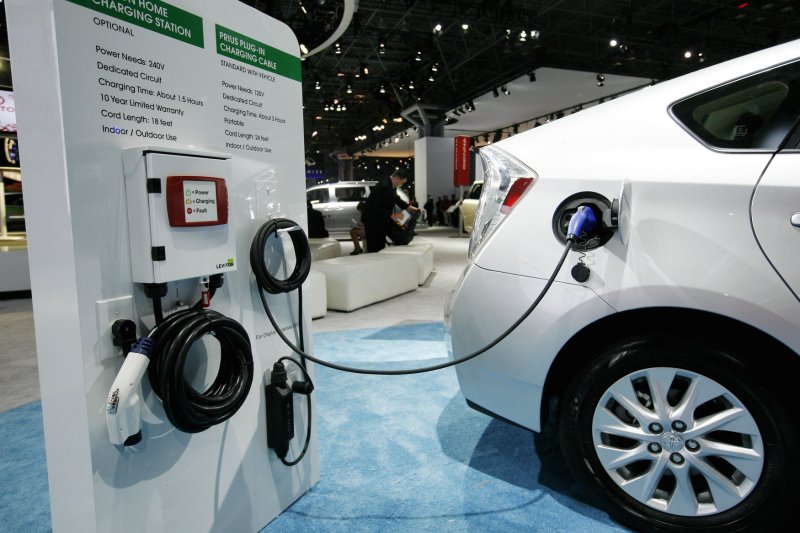1 of 2 | Most EV charging stations require a membership to use, which critics say is an obstacle for industry growth. File Photo by Monika Graff/UPI |
License Photo
Sept. 11 (UPI) -- One of the oldest arguments against widespread use of fully electric vehicles in the United States is the inconvenience of charging them, as there has never been large-scale access to stations. Market, political and economic changes, however, are slowly chipping away at that position.
Experts say the process of charging EVs in public could change drastically in the coming years, as consumers are demanding a routine that's as simplified as pumping gasoline on any street corner in the United States.
The state of California, long a bastion of environmental innovation, is leading the charge with new legislation that would require public chargers accept credit cards and other forms of payment.
California's Air Resources Board is working to end the dominant business model, which now requires a membership for drivers to charge at public stations. Experts say that can be cumbersome for first-time users who can't figure out how to operate the charger.
The charging companies "are doing everything they can to make sure they don't have to put a card reader on these machines," Electric Auto Association Director Marc Geller said. "Each of them thinks they'll be better off with a private network."
Josh Winkler, head of technology for Blink Charging, said his firm promotes non-membership access to charging stations -- but notes there are risks in using credit cards and chip readers.
"That's really where the industry is at, in looking at the tension between memberships required to start a charge and open access to anyone with a debit or credit card," Winkler said.
"With that being said, the legislative policies being promoted in California are a little bit short-sighted."
Anne Smart, vice president of EV infrastructure company Chargepoint, argues that credit card readers on un-monitored public chargers are a vulnerability that could expose drivers to fraud and other risks, especially considering many are located in parking lots.
"We are concerned," Smart said, adding that better options would be contactless credit cards or mobile payments -- because the scanning mechanisms for those are protected inside the charger housing.
Chargepoint opposes CARB's proposal to open charger access to non-members because such a move could determine the direction for the entire industry.
"We will continue to evolve and look at future payment methods as they come forward," Smart said.
"We are pushing for contactless [cards] because it's future-proof, extremely low maintenance and secure," Winkler added.
Another problem with opening stations to credit cards, experts point out, is expensive retrofitting that would have to be done to existing chargers across the United States.
Blink says it has 5,000 public stations and has sold 9,000 units worldwide. Its goal, Winkler said, is to put chargers in the places where people tend to spend long periods of time -- like restaurants, hotels, entertainment districts and business corners.
The Consortium for Battery Innovation predicts the global EV market will reach $500 million by 2025, and 120 million gas-free vehicles will be on the road in China, the United States and the European Union within a decade. That means new charging infrastructure must also grow for the industry to be successful.
"We're definitely in growth mode right now," Winkler said. "We've been building up our teams over the last year and a half."
Texas cities Austin and Houston are considering amending building codes to say new construction must include charging infrastructure. That way, charging stations can be added later much more easily. Officials in Dallas and Fort Worth are creating an ordinance that cities can adopt for new shopping centers, office buildings, parking garages and apartments that require EV infrastructure.
"We're laying out the red carpet for [electric vehicles]," Bailey Muller, senior air quality planner for the North Central Texas Council of Governments, said.
Of considerable economic interest for the industry -- and U.S. businesses -- is research that shows people with electric vehicles will spend more time and money at stores that offer EV charging.
While access to charging in public is driving the issue, Geller emphasized work and home should be the primary locations drivers power up.
"We are giving, I think, outsized attention to the question of charging in public," he said. "The perception of the need is greater than the need. There just aren't that many people who drive 200 miles in a day."
The Consortium for Battery Innovation has proposed a low-cost solution that uses established lead battery technology. CBI Director Alistair Davidson said that concept considerably drives down costs by drawing electricity from the grid when prices are low, and then storing it in batteries for later use.
The consortium is also working on a pilot program at gas stations in Missouri and possibly Kansas, and hoping to partner with convenience store chains -- the same way it has with battery manufacturers NorthStar and EnerSys.















